Application of Distributed Acoustic Sensing in Geophysics Exploration: Comparative Review of Single-Mode and Multi-Mode Fiber Optic Cables
Abstract
1. Introduction
1.1. Aim and Scope
1.2. Brief Explanation of DAS
2. Single-Mode Fiber (SMF)
2.1. Theory and Sensing Principle
2.2. Limitations of SMF
3. Multi-Mode Fiber (MMF)
3.1. Theory and Sensing Principle
3.2. Limitations of MMF
4. Application of Fiber Optic Cables in Geophysics Exploration
4.1. VSP of SMF
- Reservoir Monitoring of SMF
4.2. Microseismic Monitoring of SMF
4.3. ML Application in SMF Processing
4.4. VSP of MMF
- Reservoir Monitoring of MMF
4.5. Microseismic of MMF
- ML Application in MMF Processing
4.6. Subsurface Imaging of Combined SMF and MMF
5. Conclusions
- Successfully employed SMF cables in the domain of surface and subsurface geophysics exploration was inspected in this review. The various SMFs were used to record acoustic properties of a signal along the cable and have become the most used type of fiber optic cable for DAS. However, in this review, when SMF and MMF were combined, MMF was found to be preferable for DTS measurement in most research studies in terms of temperature variations and high bandwidth.
- The cable deployment technique is a crucial initial factor, leading to considerable efforts with respect to its DAS data processing and application in the field of geophysics exploration. This can be improved by the enhancement of preprocessing steps not limited to the control of DAS acquisition parameter optimization, improving SNR values, in addition to a comparison with other seismic measurement tools such as conventional geophones.
- DAS VSP is the most popular technique used to image the subsurface along the borehole. Furthermore, DAS for microseismic measurement was able to detect small microseismic events with high resolution. Although this method works well, it has some major drawbacks that may lead to reduced imaging resolution due to various noise for both SMF and MMF. To achieve a satisfactory resolution of the DAS data, preprocessing steps are imperative to improve data denoising. Subsequently, the ML algorithm approach offers automated DAS data denoising with high accuracy.
Author Contributions
Funding
Acknowledgments
Conflicts of Interest
References
- Gupta, D.; Rao, J.V.R.; Ramamurty, V. Subchapter 7.1—National Geophysical Mapping in Geological Survey of India—An Impetus to Mineral Exploration. In Innovative Exploration Methods for Minerals, Oil, Gas, and Groundwater for Sustainable Development; Moitra, A.K., Kayal, J.R., Mukerji, B., Bhattacharya, J., Das, A.K., Eds.; Elsevier: Amsterdam, The Netherlands, 2022; pp. 455–462. [Google Scholar] [CrossRef]
- Rossi, M.; Wisén, R.; Vignoli, G.; Coni, M. Assessment of Distributed Acoustic Sensing (DAS) Performance for Geotechnical Applications. Eng. Geol. 2022, 306, 106729. [Google Scholar] [CrossRef]
- Miah, K.; Potter, D.K. A Review of Hybrid Fiber-Optic Distributed Simultaneous Vibration and Temperature Sensing Technology and Its Geophysical Applications. Sensors 2017, 17, 2511. [Google Scholar] [CrossRef]
- Fenta, M.C.; Potter, D.K.; Szanyi, J. Fibre Optic Methods of Prospecting: A Comprehensive and Modern Branch of Geophysics. Surv. Geophys. 2021, 42, 551–584. [Google Scholar] [CrossRef]
- Pevzner, R.; Tertyshnikov, K.; Popik, S.; Sidenko, E. Reviving Reverse VSP: Good Old Technique for the Near Surface High Resolution Imaging and Rapid Monitoring* The Work Has Been Supported by the Mineral Exploration Cooperative Research Centre Whose Activities Are Funded by the Australian Government’s Cooperative Research Centre Programme. In Proceedings of the Fifth EAGE Workshop on Borehole Geophysics, The Hague, The Netherlands, 18–20 November 2019; Volume 2019, pp. 1–2. [Google Scholar] [CrossRef]
- Wren, A.E. Exploration Geophysics. In General Geology; Springer: Boston, MA, USA, 1988; pp. 122–133. [Google Scholar] [CrossRef]
- Willis, M.E. Chapter 4 Fiber optic cables. In Distributed Acoustic Sensing for Seismic Measurements—What Geophysicists and Engineers Need to Know; Society of Exploration Geophysicists: Houston, TX, USA, 2022; pp. 45–52. [Google Scholar] [CrossRef]
- Otchere, D.A.; Latiff, A.H.; Tackie-Otoo, B.N. Distributed Acoustic Sensing in Subsurface Applications—Review and Potential Integration with Artificial Intelligence for an Intelligent CO2 Storage Monitoring System. Geoenergy Sci. Eng. 2024, 237, 212818. [Google Scholar] [CrossRef]
- Sun, Y.; Li, H.; Fan, C.; Yan, B.; Chen, J.; Yan, Z.; Sun, Q. Review of a Specialty Fiber for Distributed Acoustic Sensing Technology. Photonics 2022, 9, 277. [Google Scholar] [CrossRef]
- Daley, T.M.; Freifeld, B.M.; Ajo-Franklin, J.; Dou, S.; Pevzner, R.; Shulakova, V.; Kashikar, S.; Miller, D.E.; Goetz, J.; Henninges, J.; et al. Field Testing of Fiber-Optic Distributed Acoustic Sensing (DAS) for Subsurface Seismic Monitoring. Lead. Edge 2013, 32, 699–706. [Google Scholar] [CrossRef]
- Bisyarin, M.A.; Kotov, O.I.; Hartog, A.H.; Liokumovich, L.B.; Ushakov, N.A. Rayleigh Backscattering from the Fundamental Mode in Step-Index Multimode Optical Fibers. Appl. Opt. 2017, 56, 354–364. [Google Scholar] [CrossRef]
- Weng, Y.; Ip, E.; Pan, Z.; Wang, T. Single-End Simultaneous Temperature and Strain Sensing Techniques Based on Brillouin Optical Time Domain Reflectometry in Few-Mode Fibers. Opt. Express 2015, 23, 9024–9039. [Google Scholar] [CrossRef]
- Ye, X.W.; Su, Y.H.; Han, J.P. Structural Health Monitoring of Civil Infrastructure Using Optical Fiber Sensing Technology: A Comprehensive Review. Sci. World J. 2014, 2014, 652329. [Google Scholar] [CrossRef]
- Nichols, J.M.; Trickey, S.T.; Seaver, M.; Moniz, L. Use of Fiber-Optic Strain Sensors and Holder Exponents for Detecting and Localizing Damage in an Experimental Plate Structure. J. Intell. Mater. Syst. Struct. 2007, 18, 51–67. [Google Scholar] [CrossRef]
- Murayama, H.; Kageyama, K.; Uzawa, K.; Ohara, K.; Igawa, H. Strain Monitoring of a Single-Lap Joint with Embedded Fiber-Optic Distributed Sensors. Struct. Health Monit. 2012, 11, 325–344. [Google Scholar] [CrossRef]
- Silva-Muñoz, R.A.; Lopez-Anido, R.A. Structural Health Monitoring of Marine Composite Structural Joints Using Embedded Fiber Bragg Grating Strain Sensors. Compos. Struct. 2009, 89, 224–234. [Google Scholar] [CrossRef]
- Khiat, A.; Lamarque, F.; Prelle, C.; Pouille, P.; Leester-Schädel, M.; Büttgenbach, S. Two-Dimension Fiber Optic Sensor for High-Resolution and Long-Range Linear Measurements. Sens. Actuators A Phys. 2010, 158, 43–50. [Google Scholar] [CrossRef]
- Chen, M.; Masoudi, A.; Parmigiani, F.; Brambilla, G. Distributed Acoustic Sensor Based on a Two-Mode Fiber. Opt. Express 2018, 26, 25399–25407. [Google Scholar] [CrossRef]
- Mao, Y.; Ashry, I.; Alias, M.S.; Ng, T.K.; Hveding, F.; Arsalan, M.; Ooi, B.S. Investigating the Performance of a Few-Mode Fiber for Distributed Acoustic Sensing. IEEE Photonics J. 2019, 11, 6802910. [Google Scholar] [CrossRef]
- Karrenbach, M.; Kahn, D.; Cole, S.; Ridge, A.; Boone, K.; Rich, J.; Silver, K.; Langton, D. Hydraulic-Fracturing-Induced Strain and Microseismic Using in Situ Distributed Fiber-Optic Sensing. Lead. Edge 2017, 36, 837–844. [Google Scholar] [CrossRef]
- Webster, P.; Wall, J.; Perkins, C.; Molenaar, M. Micro-Seismic Detection Using Distributed Acoustic Sensing. In SEG Technical Program Expanded Abstracts 2013; SEG Technical Program Expanded Abstracts; Society of Exploration Geophysicists: Tulsa, OK, USA, 2013; pp. 2459–2463. [Google Scholar] [CrossRef]
- Mateeva, A.; Mestayer, J.; Cox, B.; Kiyashchenko, D.; Wills, P.; Lopez, J.; Grandi, S.; Hornman, K.; Lumens, P.; Franzen, A.; et al. Advances in Distributed Acoustic Sensing (DAS) for VSP. In SEG Technical Program Expanded Abstracts 2012; SEG Technical Program Expanded Abstracts; Society of Exploration Geophysicists: Tulsa, OK, USA, 2012; pp. 1–5. [Google Scholar] [CrossRef]
- Mestayer, J.; Cox, B.; Wills, P.; Kiyashchenko, D.; Lopez, J.; Costello, M.; Bourne, S.; Ugueto, G.; Lupton, R.; Solano, G.; et al. Field Trials of Distributed Acoustic Sensing for Geophysical Monitoring. In SEG Technical Program Expanded Abstracts 2011; SEG Technical Program Expanded Abstracts; Society of Exploration Geophysicists: Tulsa, OK, USA, 2011; pp. 4253–4257. [Google Scholar] [CrossRef]
- Castongia, E.; Wang, H.F.; Lord, N.; Fratta, D.; Mondanos, M.; Chalari, A. An Experimental Investigation of Distributed Acoustic Sensing (DAS) on Lake Ice. J. Environ. Eng. Geophys. 2017, 22, 167–176. [Google Scholar] [CrossRef]
- Bostick, F.X., III. Field Experimental Results of Three-Component Fiber-Optic Seismic Sensors. In SEG Technical Program Expanded Abstracts 2000; SEG Technical Program Expanded Abstracts; Society of Exploration Geophysicists: Tulsa, OK, USA, 2000; pp. 21–24. [Google Scholar] [CrossRef]
- Keul, P.R.; Mastin, E.; Blanco, J.; Maguérez, M.; Bostick, T.; Knudsen, S. Using a Fiber-Optic Seismic Array for Well Monitoring. Lead. Edge 2005, 24, 68–70. [Google Scholar] [CrossRef]
- Molenaar, M.M.; Hill, D.J.; Webster, P.; Fidan, E.; Birch, B. First Downhole Application of Distributed Acoustic Sensing for Hydraulic-Fracturing Monitoring and Diagnostics. SPE Drill. Complet. 2012, 27, 32–38. [Google Scholar] [CrossRef]
- Daley, T.M.; Miller, D.E.; Dodds, K.; Cook, P.; Freifeld, B.M. Field Testing of Modular Borehole Monitoring with Simultaneous Distributed Acoustic Sensing and Geophone Vertical Seismic Profiles at Citronelle, Alabama. Geophys. Prospect. 2016, 64, 1318–1334. [Google Scholar] [CrossRef]
- Tejedor, J.; Macias-Guarasa, J.; Martins, H.F.; Pastor-Graells, J.; Corredera, P.; Martin-Lopez, S. Machine Learning Methods for Pipeline Surveillance Systems Based on Distributed Acoustic Sensing: A Review. Appl. Sci. 2017, 7, 841. [Google Scholar] [CrossRef]
- Posey, R.; Johnson, G.A.; Vohra, S.T. Strain Sensing Based on Coherent Rayleigh Scattering in an Optical Fibre. Electron. Lett. 2000, 36, 1688–1689. [Google Scholar] [CrossRef]
- Healey, P. Fading in Heterodyne OTDR. Electron. Lett. 1984, 20, 30–32. [Google Scholar] [CrossRef]
- Zhou, J.; Pan, Z.; Ye, Q.; Cai, H.; Qu, R.; Fang, Z. Characteristics and Explanations of Interference Fading of a ϕ-OTDR With a Multi-Frequency Source. J. Lightwave Technol. 2013, 31, 2947–2954. [Google Scholar] [CrossRef]
- Ren, M.; Lu, P.; Chen, L.; Bao, X. Theoretical and Experimental Analysis of Φ-OTDR Based on Polarization Diversity Detection. IEEE Photonics Technol. Lett. 2016, 28, 697–700. [Google Scholar] [CrossRef]
- Qin, Z.; Zhu, T.; Chen, L.; Bao, X. High Sensitivity Distributed Vibration Sensor Based on Polarization-Maintaining Configurations of Phase-OTDR. IEEE Photonics Technol. Lett. 2011, 23, 1091–1093. [Google Scholar] [CrossRef]
- Juarez, J.C.; Taylor, H.F. Polarization Discrimination in a Phase-Sensitive Optical Time-Domain Reflectometer Intrusion-Sensor System. Opt. Lett. 2005, 30, 3284–3286. [Google Scholar] [CrossRef]
- Rao, Y.-J.; Luo, J.; Ran, Z.-L.; Yue, J.-F.; Luo, X.-D.; Zhou, Z. Long-Distance Fiber-Optic Φ-OTDR Intrusion Sensing System. In Proceedings of the 20th International Conference on Optical Fibre Sensors, Edinburgh, UK, 5–9 October 2009; Volume 7503, p. 75031O. [Google Scholar] [CrossRef]
- Westbrook, P.S.; Feder, K.S.; Kremp, T.; Monberg, E.M.; Wu, H.; Zhu, B.; Huang, L.; Simoff, D.A.; Shenk, S.; Handerek, V.A.; et al. Enhanced Optical Fiber for Distributed Acoustic Sensing beyond the Limits of Rayleigh Backscattering. iScience 2020, 23, 101137. [Google Scholar] [CrossRef]
- Liokumovich, L.B.; Ushakov, N.A.; Kotov, O.I.; Bisyarin, M.A.; Hartog, A.H. Fundamentals of Optical Fiber Sensing Schemes Based on Coherent Optical Time Domain Reflectometry: Signal Model Under Static Fiber Conditions. J. Lightwave Technol. 2015, 33, 3660–3671. [Google Scholar] [CrossRef]
- Sillard, P.; Bigot-Astruc, M.; Molin, D. Few-Mode Fibers for Mode-Division-Multiplexed Systems. J. Lightwave Technol. 2014, 32, 2824–2829. [Google Scholar] [CrossRef]
- Willis, M.E.; Ellmauthaler, A.; LeBlanc, M.; Palacios, W.; Wu, X. Comparing Distributed Acoustic Sensing, Vertical Seismic Profile Data Acquired with Single- and Multi-Mode Fiber Optic Cables. In SEG Technical Program Expanded Abstracts 2018; SEG Technical Program Expanded Abstracts; Society of Exploration Geophysicists: Tulsa, OK, USA, 2018; pp. 4674–4678. [Google Scholar] [CrossRef]
- Yamate, T.; Fujisawa, G.; Ikegami, T. Optical Sensors for the Exploration of Oil and Gas. J. Lightwave Technol. 2017, 35, 3538–3545. [Google Scholar] [CrossRef]
- Mao, Y.; Ashry, I.; Hveding, F.; Bukhamsin, A.Y.; Hong, Y.; Ng, T.K.; Ooi, B.S. Simultaneous Distributed Acoustic and Temperature Sensing Using a Multimode Fiber. IEEE J. Sel. Top. Quantum Electron. 2020, 26, 5600207. [Google Scholar] [CrossRef]
- Ashry, I.; Mao, Y.; Trichili, A.; Wang, B.; Ng, T.K.; Alouini, M.-S.; Ooi, B.S. A Review of Using Few-Mode Fibers for Optical Sensing. IEEE Access 2020, 8, 179592–179605. [Google Scholar] [CrossRef]
- Bao, X.; Chen, L. Recent Progress in Distributed Fiber Optic Sensors. Sensors 2012, 12, 8601–8639. [Google Scholar] [CrossRef]
- Palmieri, L. Coupling Mechanism in Multimode Fibers. In Next-Generation Optical Communication: Components, Sub-Systems, and Systems III; SPIE: Bellingham, WA, USA, 2014; Volume 9009, p. 90090G. [Google Scholar] [CrossRef]
- Qiu, T.; Ashry, I.; Wang, A.; Xu, Y. Adaptive Mode Control in 4- and 17-Mode Fibers. IEEE Photonics Technol. Lett. 2018, 30, 1036–1039. [Google Scholar] [CrossRef]
- Ma, X.; Chang, J.; Wang, Z.; Wang, W.; Li, T. Using Multiple Reference Points in Raman Based Distributed Temperature Sensor for Eliminating DC Interference. IEEE Sens. J. 2014, 14, 295–301. [Google Scholar] [CrossRef]
- Bao, X.; Zhou, D.-P.; Baker, C.; Chen, L. Recent Development in the Distributed Fiber Optic Acoustic and Ultrasonic Detection. J. Lightwave Technol. 2017, 35, 3256–3267. [Google Scholar] [CrossRef]
- Zhang, Z.; Wang, J.; Li, Y.; Gong, H.; Yu, X.; Liu, H.; Jin, Y.; Kang, J.; Li, C.; Zhang, W.; et al. Recent Progress in Distributed Optical Fiber Raman Photon Sensors at China Jiliang University. Photonic Sens. 2012, 2, 127–147. [Google Scholar] [CrossRef][Green Version]
- Noble, M.D.; Lambert, R.A.; Ahmed, H.; Lyons, J. The Application of Three-Component VSP Data on the Interpretation of the Vulcan Gas Field and Its Impact on Field Development. First Break 1988, 6. [Google Scholar] [CrossRef]
- Daley, T.M.; Robertson, M.; Freifeld, B.M.; White, D.; Miller, D.E.; Herkenhoff, F.; Cocker, J. Simultaneous Acquisition of Distributed Acoustic Sensing VSP with Multi-Mode and Single-Mode Fiber Optic Cables and 3-Component Geophones at the Aquistore CO2 Storage Site. In SEG Technical Program Expanded Abstracts 2014; SEG Technical Program Expanded Abstracts; Society of Exploration Geophysicists: Tulsa, OK, USA, 2014; pp. 5014–5018. [Google Scholar] [CrossRef][Green Version]
- Harris, K.; White, D.; Samson, C.C.M.; Daley, T.; Miller, D.E. Evaluation of Distributed Acoustic Sensing for 3D Time-Lapse VSP Monitoring of the Aquistore CO2 Storage Site. In Proceedings of the GeoConvention 2015, Calgary, AB, Canada, 4–8 May 2015. [Google Scholar]
- Yurikov, A.; Tertyshnikov, K.; Isaenkov, R.; Sidenko, E.; Yavuz, S.; Glubokovskikh, S.; Barraclough, P.; Shashkin, P.; Pevzner, R. Multiwell 3D Distributed Acoustic Sensing Vertical Seismic Profile Imaging with Engineered Fibers: CO2CRC Otway Project Case Study. Geophysics 2021, 86, D241–D248. [Google Scholar] [CrossRef]
- Olofsson, B.; Martinez, A. Validation of DAS Data Integrity against Standard Geophones—DAS Field Test at Aquistore Site. Lead. Edge 2017, 36, 981–986. [Google Scholar] [CrossRef]
- Mad Zahir, M.H.; Abdul Aziz, K.M.; Ghazali, A.R.; Abdul Latiff, A.H. Effectiveness of Fiber Optic Distributed Acoustic Sensing (DAS) in Vertical Seismic Profiling (VSP) Field Survey. Appl. Sci. 2023, 13, 5002. [Google Scholar] [CrossRef]
- Ellmauthaler, A.; LeBlanc, M.; Bush, J.; Willis, M.E.; Maida, J.L.; Wilson, G.A. Real-Time DAS VSP Acquisition and Processing on Single- and Multi-Mode Fibers. IEEE Sens. J. 2021, 21, 14847–14852. [Google Scholar] [CrossRef]
- Correa, J.; Isaenkov, R.; Yavuz, S.; Yurikov, A.; Tertyshnikov, K.; Wood, T.; Freifeld, B.M.; Pevzner, R. Distributed Acoustic Sensing/Surface Orbital Vibrator: Rotary Seismic Sources with Fiber-Optic Sensing Facilitates Autonomous Permanent Reservoir Monitoring. Geophysics 2021, 86, P61–P68. [Google Scholar] [CrossRef]
- Ajo-Franklin, J.; Dou, S.; Daley, T.; Freifeld, B.; Robertson, M.; Ulrich, C.; Wood, T.; Eckblaw, I.; Lindsey, N.; Martin, E.; et al. Time-Lapse Surface Wave Monitoring of Permafrost Thaw Using Distributed Acoustic Sensing and a Permanent Automated Seismic Source. In SEG Technical Program Expanded Abstracts 2017; SEG Technical Program Expanded Abstracts; Society of Exploration Geophysicists: Tulsa, OK, USA, 2017; pp. 5223–5227. [Google Scholar] [CrossRef]
- Zwartjes, P.; Mateeva, A.; Tatanova, M.; Chalenski, D.; Yang, Z.; Lopez, J.; de Vos, K.; Potters, H. 4D DAS VSP in Deepwater: Proof of Concept and next Steps. In SEG Technical Program Expanded Abstracts 2017; SEG Technical Program Expanded Abstracts; Society of Exploration Geophysicists: Tulsa, OK, USA, 2017; pp. 5802–5807. [Google Scholar] [CrossRef]
- Lumley, D.E. Time-lapse Seismic Reservoir Monitoring. Geophysics 2001, 66, 50–53. [Google Scholar] [CrossRef]
- Wilson, G.A.; Willis, M.E.; Ellmauthaler, A. Evaluating 3D and 4D DAS VSP Image Quality of Subsea Carbon Storage. Lead. Edge 2021, 40, 261–266. [Google Scholar] [CrossRef]
- Correa, J.; Egorov, A.; Tertyshnikov, K.; Bona, A.; Pevzner, R.; Dean, T.; Freifeld, B.; Marshall, S. Analysis of Signal to Noise and Directivity Characteristics of DAS VSP at near and Far Offsets—A CO2CRC Otway Project Data Example. Lead. Edge 2017, 36, a1–a994. [Google Scholar] [CrossRef]
- Ikeda, T.; Tsuji, T. Robust Subsurface Monitoring Using a Continuous and Controlled Seismic Source. Energy Procedia 2017, 114, 3956–3960. [Google Scholar] [CrossRef]
- Kasahara, J.; Hasada, Y. Chapter 3—Active Seismic Approach by Accurately Controlled and Routinely Operated Signal System. In Time Lapse Approach to Monitoring Oil, Gas, and CO2 Storage by Seismic Methods; Kasahara, J., Hasada, Y., Eds.; Gulf Professional Publishing: Woburn, MA, USA, 2017; pp. 15–34. [Google Scholar] [CrossRef]
- Webster, P.J.; Cox, B.; Molenaar, M.M. Distributed Acoustic Sensing for Cross-Well Frac Monitoring. In Proceedings of the Geoconvention 2014, Calgary, CA, USA, 12–16 May 2014. [Google Scholar]
- Karrenbach, M.; Cole, S.; Ridge, A.; Boone, K.; Kahn, D.; Rich, J.; Silver, K.; Langton, D. Fiber-Optic Distributed Acoustic Sensing of Microseismicity, Strain and Temperature during Hydraulic Fracturing. Geophysics 2019, 84, D11–D23. [Google Scholar] [CrossRef]
- Lellouch, A.; Luo, B.; Huot, F.; Clapp, R.G.; Given, P.; Biondi, E.; Nemeth, T.; Nihei, K.T.; Biondi, B.L. Microseismic Analysis over a Single Horizontal Distributed Acoustic Sensing Fiber Using Guided Waves. Geophysics 2022, 87, KS83–KS95. [Google Scholar] [CrossRef]
- Masoudi, A.; Newson, T.P. Contributed Review: Distributed Optical Fibre Dynamic Strain Sensing. Rev. Sci. Instrum. 2016, 87, 011501. [Google Scholar] [CrossRef]
- Pastor-Graells, J.; Cortés, L.R.; Fernández-Ruiz, M.R.; Martins, H.F.; Azaña, J.; Martin-Lopez, S.; Gonzalez-Herraez, M. SNR Enhancement in High-Resolution Phase-Sensitive OTDR Systems Using Chirped Pulse Amplification Concepts. Opt. Lett. 2017, 42, 1728–1731. [Google Scholar] [CrossRef]
- Van den Ende, M.; Lior, I.; Ampuero, J.-P.; Sladen, A.; Ferrari, A.; Richard, C. A Self-Supervised Deep Learning Approach for Blind Denoising and Waveform Coherence Enhancement in Distributed Acoustic Sensing Data. IEEE Trans. Neural Netw. Learn. Syst. 2023, 34, 3371–3384. [Google Scholar] [CrossRef]
- Stork, A.L.; Baird, A.F.; Horne, S.A.; Naldrett, G.; Lapins, S.; Kendall, J.-M.; Wookey, J.; Verdon, J.P.; Clarke, A.; Williams, A. Application of Machine Learning to Microseismic Event Detection in Distributed Acoustic Sensing Data. Geophysics 2020, 85, KS149–KS160. [Google Scholar] [CrossRef]
- Bublin, M. Event Detection for Distributed Acoustic Sensing: Combining Knowledge-Based, Classical Machine Learning, and Deep Learning Approaches. Sensors 2021, 21, 7527. [Google Scholar] [CrossRef]
- Saad, O.M.; Oboué, Y.A.S.I.; Bai, M.; Samy, L.; Yang, L.; Chen, Y. Self-Attention Deep Image Prior Network for Unsupervised 3-D Seismic Data Enhancement. IEEE Trans. Geosci. Remote Sens. 2022, 60, 1–14. [Google Scholar] [CrossRef]
- Lapins, S.; Butcher, A.; Kendall, J.-M.; Hudson, T.S.; Stork, A.L.; Werner, M.J.; Gunning, J.; Brisbourne, A.M. DAS-N2N: Machine Learning Distributed Acoustic Sensing (DAS) Signal Denoising without Clean Data. Geophys. J. Int. 2023, 236, 1026–1041. [Google Scholar] [CrossRef]
- Yu, G.; Cai, Z.; Chen, Y.; Wang, X.; Zhang, Q.; Li, Y.; Wang, Y.; Liu, C.; Zhao, B.; Greer, J. Borehole seismic survey using multimode optical fibers in a hybrid wireline. Measurement 2018, 125, 694–703. [Google Scholar] [CrossRef]
- Kiyashchenko, D.; Mateeva, A.; Duan, Y.; Johnson, D.; Pugh, J.; Geisslinger, A.; Lopez, J. Frequent 4D Monitoring with DAS 3D VSP in Deep Water to Reveal Injected Water-Sweep Dynamics. Lead. Edge 2020, 39, 471–479. [Google Scholar] [CrossRef]
- Cole, S.; Karrenbach, M.; Kahn, D.; Rich, J.; Silver, K.; Langton, D. Source Parameter Estimation from DAS Microseismic Data. In SEG Technical Program Expanded Abstracts 2018; SEG Technical Program Expanded Abstracts; Society of Exploration Geophysicists: Tulsa, OK, USA, 2018; pp. 4928–4932. [Google Scholar] [CrossRef]
- Eaid, M.; Hu, C.; Zhang, L.; Keating, S.; Innanen, K. Estimation of DAS Microseismic Source Mechanisms Using Unsupervised Deep Learning. In First International Meeting for Applied Geoscience & Energy Expanded Abstracts; SEG Technical Program Expanded Abstracts; Society of Exploration Geophysicists: Tulsa, OK, USA, 2021; pp. 407–411. [Google Scholar] [CrossRef]
- Binder, G.; Tura, A. Convolutional Neural Networks for Automated Microseismic Detection in Downhole Distributed Acoustic Sensing Data and Comparison to a Surface Geophone Array. Geophys. Prospect. 2020, 68, 2770–2782. [Google Scholar] [CrossRef]
- Li, F.; Zhou, H.; Wang, Z.; Wu, X. ADDCNN: An Attention-Based Deep Dilated Convolutional Neural Network for Seismic Facies Analysis With Interpretable Spatial–Spectral Maps. IEEE Trans. Geosci. Remote Sens. 2021, 59, 1733–1744. [Google Scholar] [CrossRef]
- Ku, B.; Kim, G.; Ahn, J.-K.; Lee, J.; Ko, H. Attention-Based Convolutional Neural Network for Earthquake Event Classification. IEEE Geosci. Remote Sens. Lett. 2021, 18, 2057–2061. [Google Scholar] [CrossRef]
- LeCun, Y.; Bengio, Y.; Hinton, G. Deep Learning. Nature 2015, 521, 436–444. [Google Scholar] [CrossRef]
- Huot, F.; Lellouch, A.; Given, P.; Clapp, R.G.; Biondi, B.L.; Nemeth, T.; Nihei, K. Detecting Microseismic Events on DAS Fiber with Super-Human Accuracy. In First International Meeting for Applied Geoscience & Energy Expanded Abstracts; SEG Technical Program Expanded Abstracts; Society of Exploration Geophysicists: Tulsa, OK, USA, 2021; pp. 3174–3178. [Google Scholar] [CrossRef]
- Ma, Y.; Eaton, D.; Igonin, N.; Wang, C. Machine Learning-Assisted Processing Workflow for Multi-Fiber DAS Microseismic Data. Front. Earth Sci. 2023, 11, 1096212. [Google Scholar] [CrossRef]
- Booth, A.D.; Christoffersen, P.; Schoonman, C.; Clarke, A.; Hubbard, B.; Law, R.; Doyle, S.H.; Chudley, T.R.; Chalari, A. Distributed Acoustic Sensing of Seismic Properties in a Borehole Drilled on a Fast-Flowing Greenlandic Outlet Glacier. Geophys. Res. Lett. 2020, 47, e2020GL088148. [Google Scholar] [CrossRef]
- Reinsch, T.; Henninges, J.; Götz, J.; Jousset, P.; Bruhn, D.; Lüth, S. Distributed Acoustic Sensing Technology for Seismic Exploration in Magmatic Geothermal Areas. In Proceedings of the World Geothermal Congress, Melbourne, Australia, 19–25 April 2015. [Google Scholar]
- White, D.; Bellefleur, G.; Dodds, K.; Movahedzadeh, Z. Toward Improved Distributed Acoustic Sensing Sensitivity for Surface-Based Reflection Seismics: Configuration Tests at the Aquistore CO2 Storage Site. Geophysics 2022, 87, P1–P14. [Google Scholar] [CrossRef]
- Harris, K.; White, D.; Samson, C. Imaging the Aquistore Reservoir after 36 Kilotonnes of CO2 Injection Using Distributed Acoustic Sensing. Geophysics 2017, 82, M81–M96. [Google Scholar] [CrossRef]
- Thomas, P.; Kolltveit, E.; Heggelund, Y.; Wilks, M.; Wuestefeld, A.; Midttømme, K.; Landrø, M. Exploring Geophysical Applications for Distributed Acoustic Sensing (DAS) Using A Flexible Interrogator Research Platform. In Proceedings of the Fifth CO2 Geological Storage Workshop, Utrecht, The Netherlands, 21–23 November 2018; Volume 2018. [Google Scholar] [CrossRef]
- Neal, J.; Krohn, C. Higher Resolution Subsurface Imaging. J. Pet. Technol. 2012, 64, 44–53. [Google Scholar] [CrossRef]
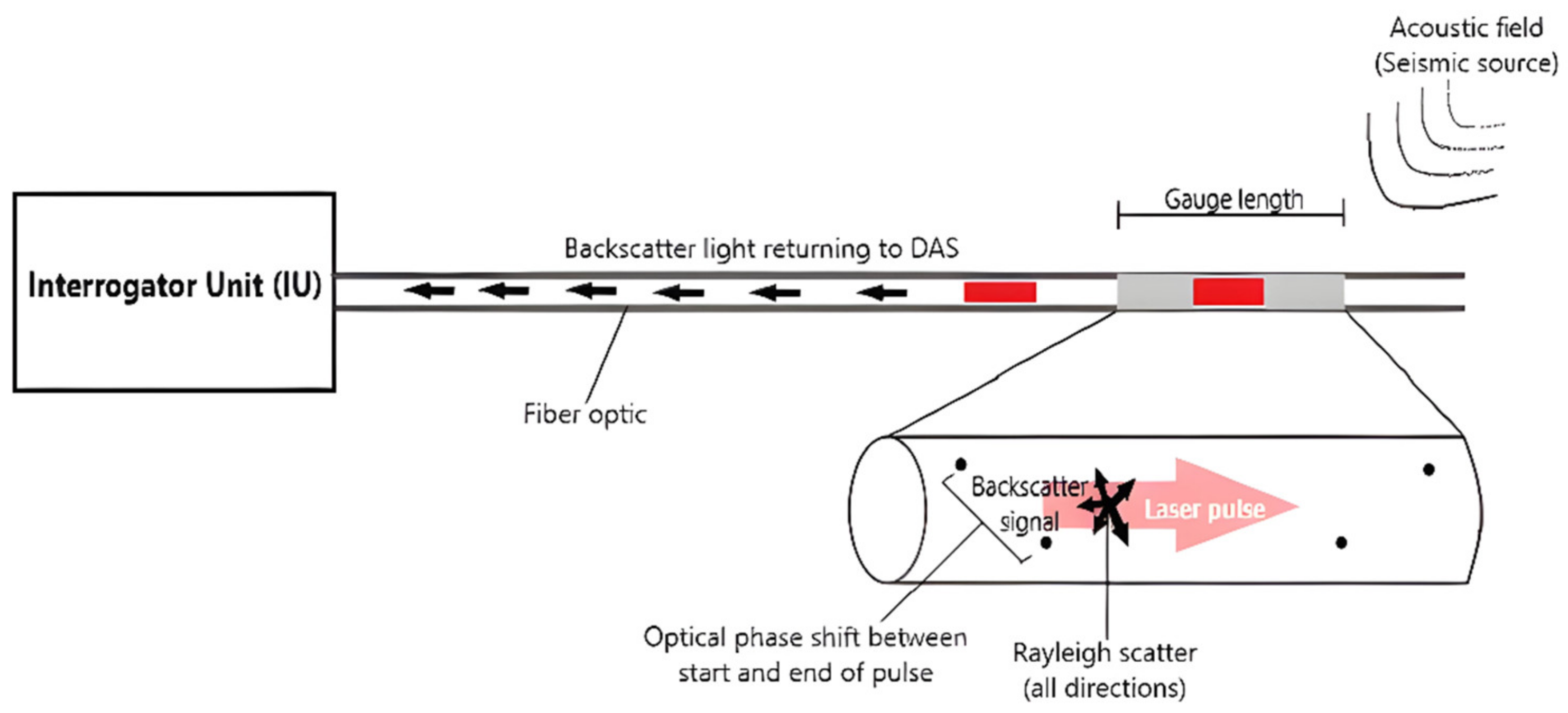
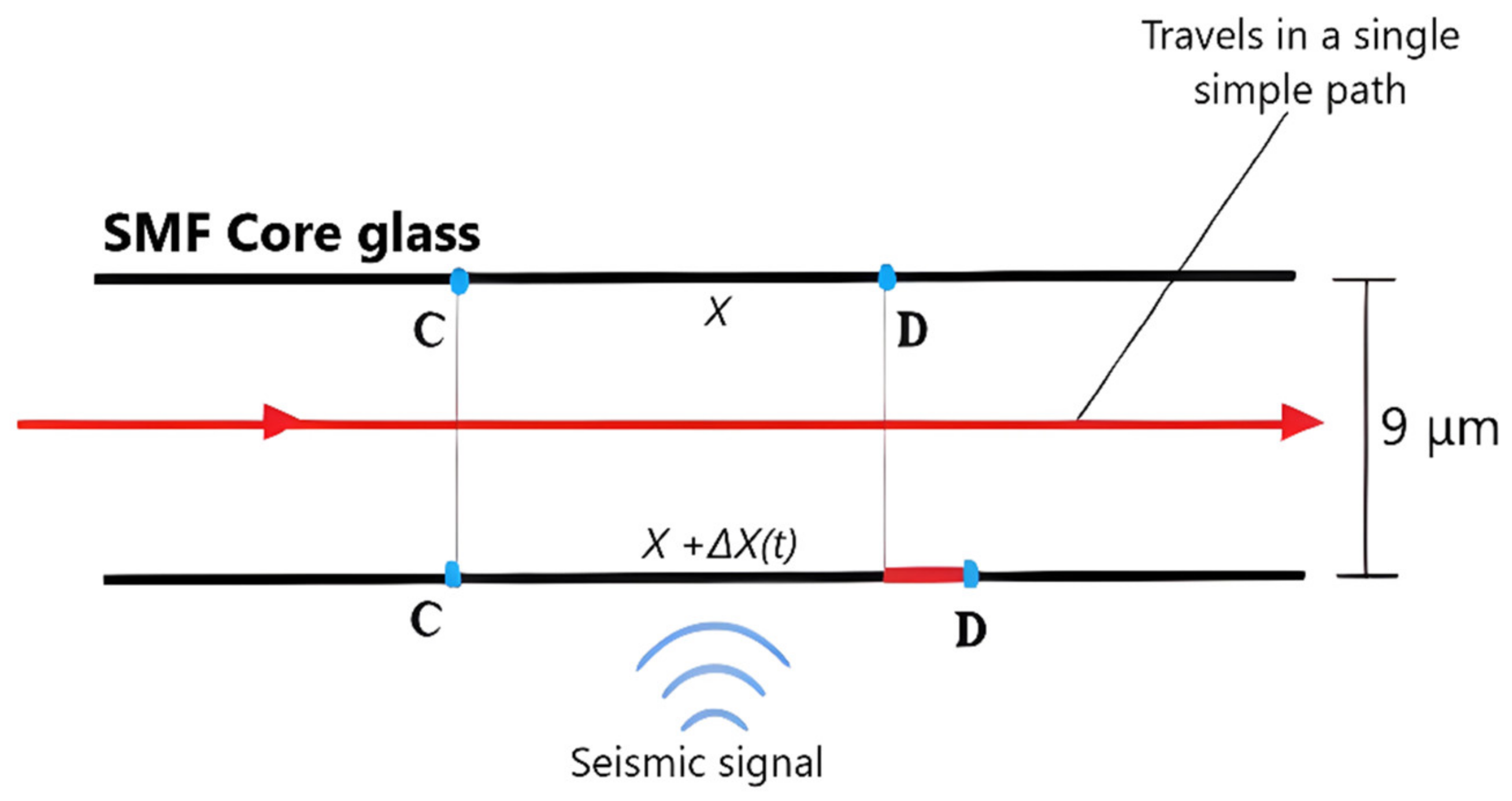
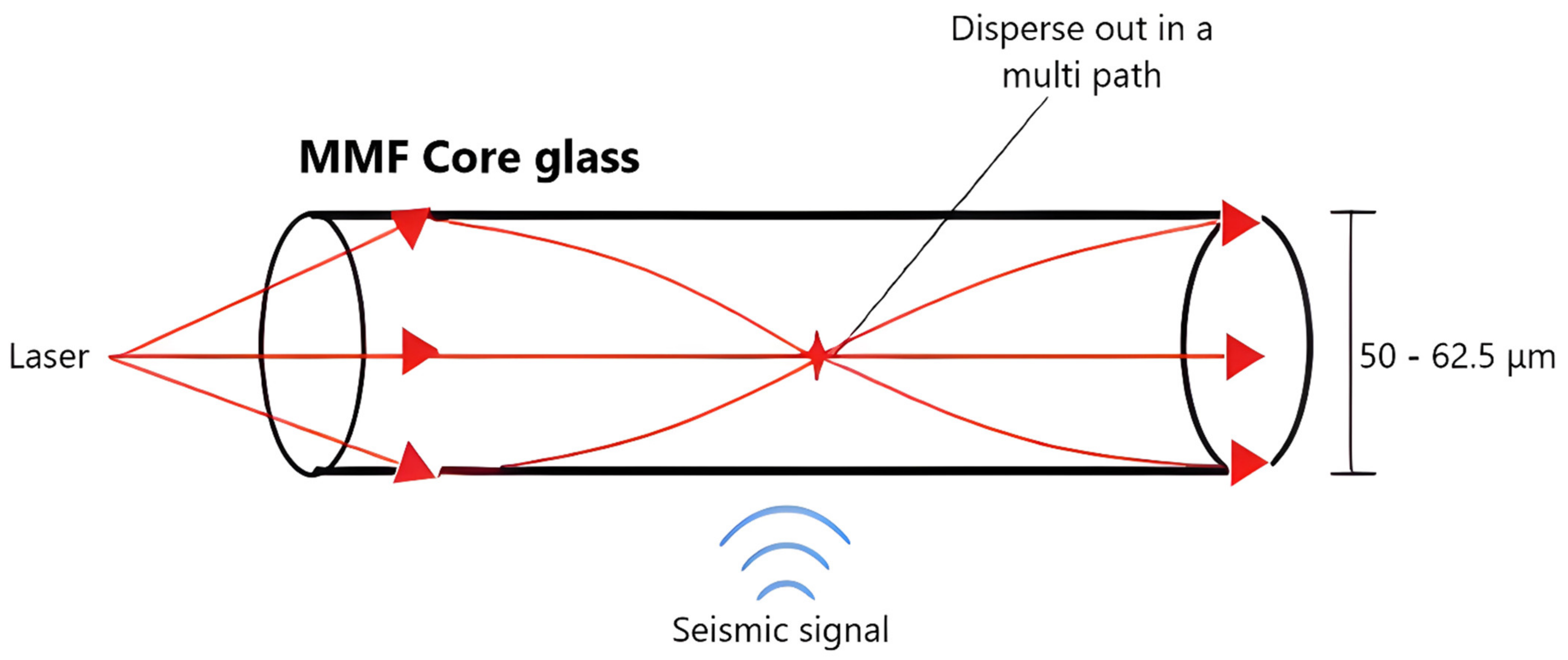

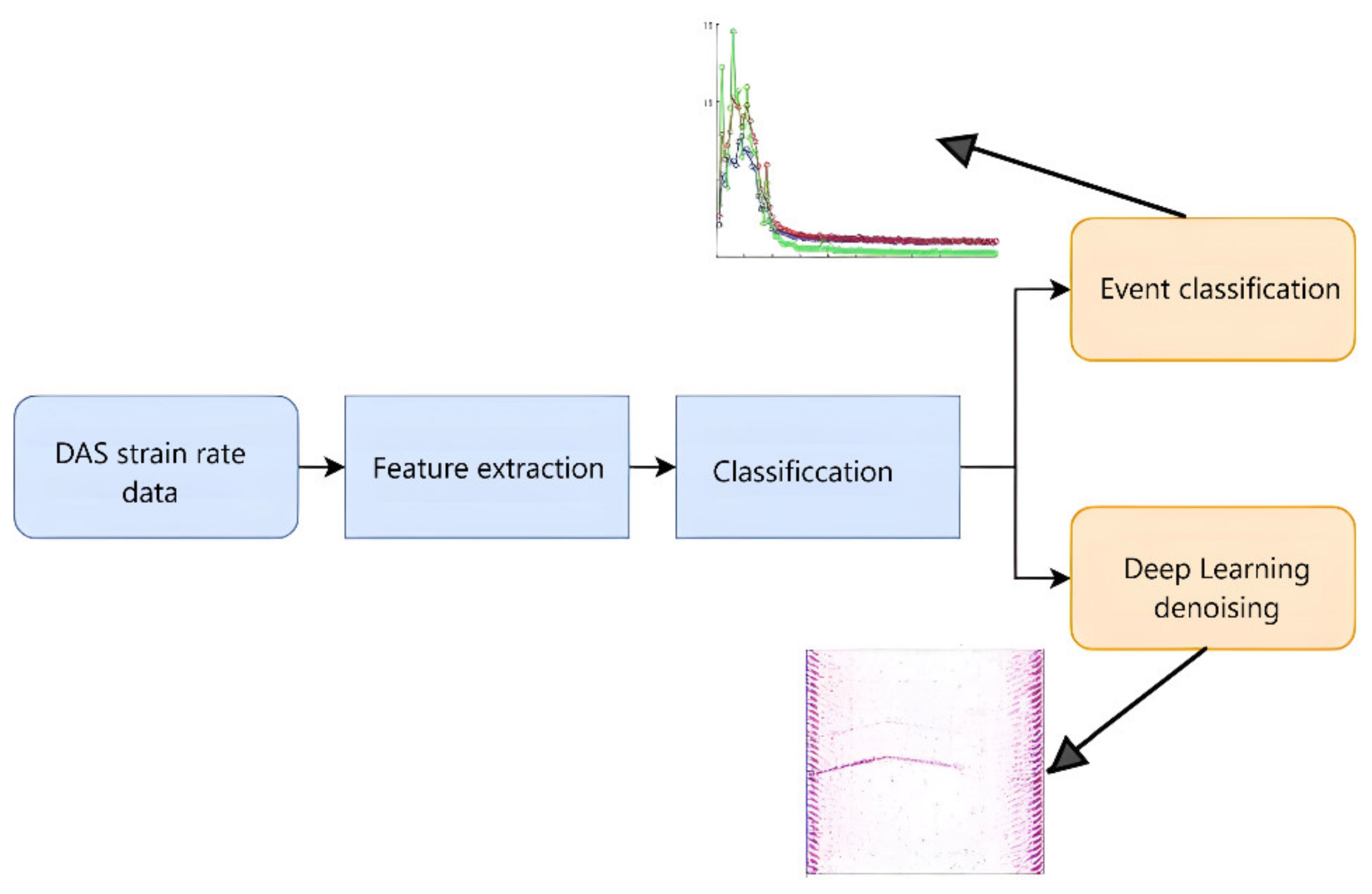

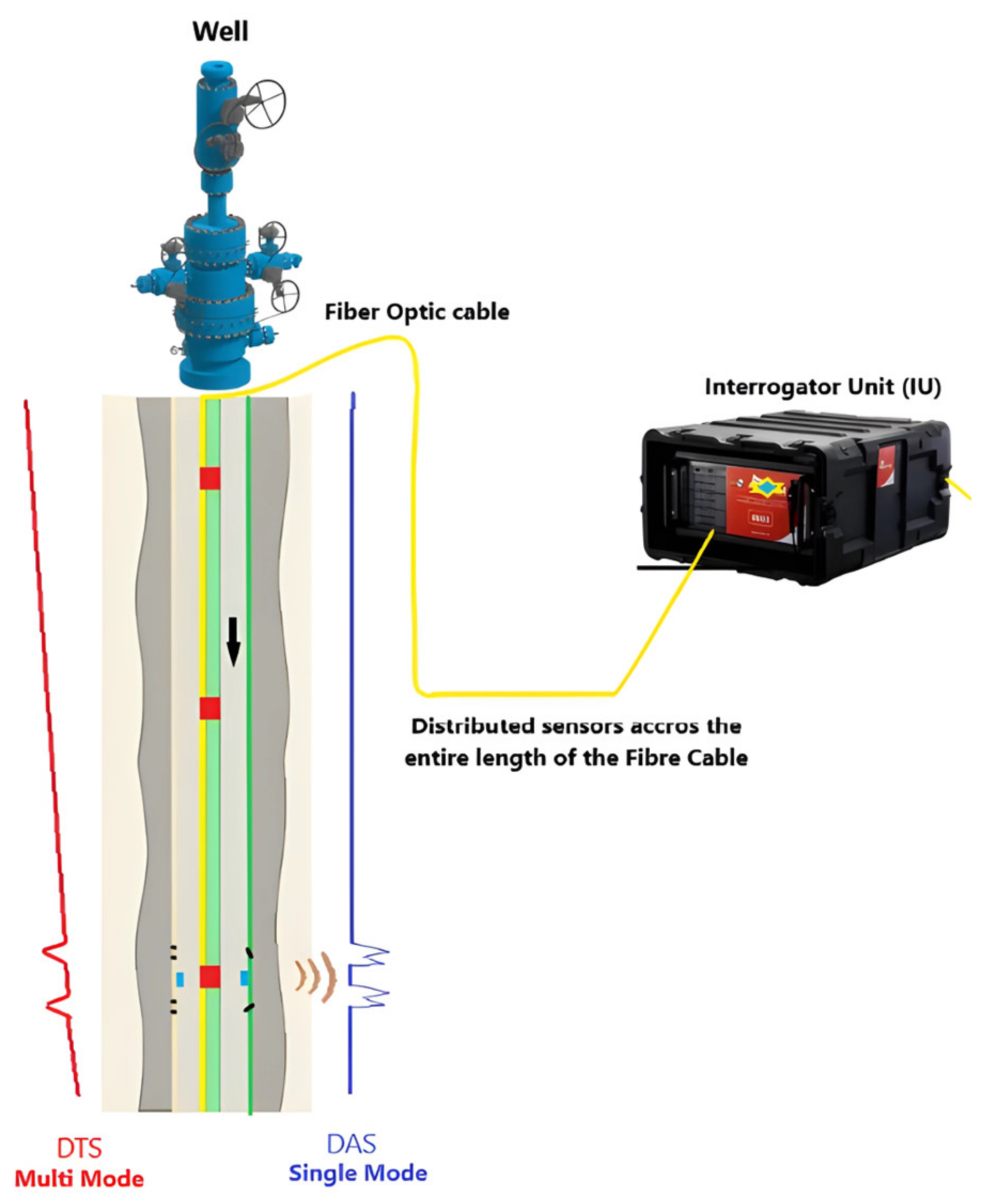
| Fiber Optic Cable Type | Advantages | Limitations |
|---|---|---|
| SMF | Most widely used in DAS monitoring and imaging | Sensitive into acquisition optical noise |
| Higher spatial resolution | ||
| Lower signal loss that minimizes signal attenuation | Interference fading | |
| MMF | Capable of DTS measurement | Unpredictable signal that can produce noisy data |
| Lower manufacturing cost | Intermodal coupling due to multiple paths of laser travel | |
| Suitable for sort-distance DAS measurement |
| Authors | Scope of Work | SMF Deployment | Outcome |
|---|---|---|---|
| Harris et al. [52] | DAS VSP | Installed inside steel tubing, strapped to the casing, and cemented in the well | Comparison of seismic images obtained by a baseline DAS and traditional geophone VSP at a CO2 storage site |
| Yurikov et al. [53] | 3D DAS VSP | Cemented along the four wells | 3D DAS VSP imaging of key stratigraphy horizon and CO2 injection target |
| Olofsson and Martinez [54] | DAS VSP | Permanently cemented behind casing | Conversion of DAS VSP data to equivalent geophone data proved to help in the up- and down-going separation step without using deep filters |
| Mad et al. [55] | DAS VSP | Four deployments strategies: cemented behind casing, cable behind an inflatable liner, strapped to production tubing, and wireline deployment | Cementing the fiber cable behind casing was considered the most effective method for coupling with the subsurface formation |
| Ellmauthaler et al. [56] | Real-time DAS VSP | Permanently deployed behind casing in vertical and lateral sections of a well | Utilization of SMF cable in the DAS system facilitated efficient data management and enabled real-time generation of seismic and navigation data sampled at specific intervals |
| Wilson et al. [61] | Subsea reservoir monitoring | Attached to subsea infrastructure and deployed in a borehole | The repercussions of increased noise on the subsea DAS image quality |
| Correa et al. [62] | Autonomous permanent reservoir monitoring | Cemented behind casing inside a borehole | Evident in time-lapse operations carried out using the DAS SMF system with favorable data quality attributes and encompassing SNR |
| Authors | Scope of Work | SMF Deployment | Outcome |
|---|---|---|---|
| Karrenbach et al. [66] | Microseismic event detection | Installed in a horizontal well behind casing in a deviated drilled well | Automatic detection of microseismic events with high accuracy in an unconventional reservoir |
| Bublin [72] | Machine learning algorithm | Laid out on a surface in a suburban area | Machine learning and deep learning applied to DAS data could detect various intrusion events along the pipeline, including manual digging and tapping |
| Lapins et al. [74] | Machine learning-assisted | Deployed on the surface in an ice stream | The supervised ML method was able to denoise DAS data automatically with a higher SNR and faster processing speed |
| Author | Scope of Work | MMF Deployment | Outcome |
|---|---|---|---|
| Yu et al. [75] | DAS VSP | Deployed within hybrid optical–electric wireline cable | Excellent vertical and lateral imaging resolution and detailed subsurface structure |
| Ellmauthaler et al. [56] | Real-time DAS VSP | Permanently deployed behind casing in vertical and lateral sections of a well | Reduction in SNR for DAS VSP and MMF had sufficient capacity for the DAS interrogator |
| Kiyashchenko et al. [76] | 4D reservoir monitoring | Deployed in active deep-water wells | DAS 4D images exhibited qualitative similarity to OBN 4D outcomes and subsurface images, facilitating the assessment of water flood injection to the reservoir |
| Wilson et al. [61] | Subsea reservoir monitoring | Attached to subsea infrastructure and deployed in a borehole | The repercussions of increased noise for subsea DAS image quality |
| Correa et al. [62] | Autonomous permanent reservoir monitoring | Cemented behind casing inside a borehole | Evident in time-lapse operations carried out using the DAS SMF system, with favorable data quality attributes and encompassing SNR |
| Authors | Scope of Work | MMF Deployment | Outcome |
|---|---|---|---|
| Karrenbach et al. [66] | Microseismic events detection | Installed in a horizontal well behind a casing in a deviated drilled well | Automatically detected microseismic events with high accuracy in an unconventional reservoir |
| Ma et al. [84] | Machine learning algorithm | Deployed on multiwell DAS datasets acquired during hydraulic fracturing well completions | Machine learning algorithm and CNN automatically detected microseismic events (hypocenter location) recorded in low-SNR DAS data |
| Authors | Scope of Work | Cable Deployment | Outcome |
|---|---|---|---|
| Daley et al. [28] | Simultaneous DAS VSP | Cemented outside of the well casing | No significant difference in the comparison of SMF and MMF recording results, and SNRs were improved by weighted stacking pf DAS VSP data |
| Booth et al. [85] | DAS VSP on Store Glacier | Installed in a borehole enclosed in a gel-filled, stainless-steel capillary tube | DAS VSP was able to detect the sediment layer and interpret temperate ice and seismic properties in transitions of ice-crystal fabric and temperature regime |
| Reinsch et al. [86] | Seismic exploration in geothermal areas | Surface layout (x and y directions) and deployed behind casing inside the well (z direction) | DAS with data from the seismic network deployed at the surface increased the resolution of the seismic data and proved to be suitable for geothermal environments |
| White et al. [87] | DAS VSP configuration test | Cemented behind well casing and buried in a shallow trench (surface) | Surface DAS fiber configurations increased the sensitivity to steep-angle P-waves of seismic reflections |
| Harris et al. [88] | Aquistore reservoir imaging | Inside stainless-steel tubing clamped to the outside of the well casing and cemented in place | DAS VSP produced time-lapse monitoring and accurately imaged NRMS values and CO2-based anomalies at specific reservoir depths |
Disclaimer/Publisher’s Note: The statements, opinions and data contained in all publications are solely those of the individual author(s) and contributor(s) and not of MDPI and/or the editor(s). MDPI and/or the editor(s) disclaim responsibility for any injury to people or property resulting from any ideas, methods, instructions or products referred to in the content. |
© 2024 by the authors. Licensee MDPI, Basel, Switzerland. This article is an open access article distributed under the terms and conditions of the Creative Commons Attribution (CC BY) license (https://creativecommons.org/licenses/by/4.0/).
Share and Cite
Rafi, M.; Mohd Noh, K.A.; Abdul Latiff, A.H.; Otchere, D.A.; Tackie-Otoo, B.N.; Putra, A.D.; Riyadi, Z.A.; Asfha, D.T. Application of Distributed Acoustic Sensing in Geophysics Exploration: Comparative Review of Single-Mode and Multi-Mode Fiber Optic Cables. Appl. Sci. 2024, 14, 5560. https://doi.org/10.3390/app14135560
Rafi M, Mohd Noh KA, Abdul Latiff AH, Otchere DA, Tackie-Otoo BN, Putra AD, Riyadi ZA, Asfha DT. Application of Distributed Acoustic Sensing in Geophysics Exploration: Comparative Review of Single-Mode and Multi-Mode Fiber Optic Cables. Applied Sciences. 2024; 14(13):5560. https://doi.org/10.3390/app14135560
Chicago/Turabian StyleRafi, Muhammad, Khairul Arifin Mohd Noh, Abdul Halim Abdul Latiff, Daniel Asante Otchere, Bennet Nii Tackie-Otoo, Ahmad Dedi Putra, Zaky Ahmad Riyadi, and Dejen Teklu Asfha. 2024. "Application of Distributed Acoustic Sensing in Geophysics Exploration: Comparative Review of Single-Mode and Multi-Mode Fiber Optic Cables" Applied Sciences 14, no. 13: 5560. https://doi.org/10.3390/app14135560
APA StyleRafi, M., Mohd Noh, K. A., Abdul Latiff, A. H., Otchere, D. A., Tackie-Otoo, B. N., Putra, A. D., Riyadi, Z. A., & Asfha, D. T. (2024). Application of Distributed Acoustic Sensing in Geophysics Exploration: Comparative Review of Single-Mode and Multi-Mode Fiber Optic Cables. Applied Sciences, 14(13), 5560. https://doi.org/10.3390/app14135560









